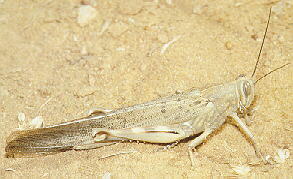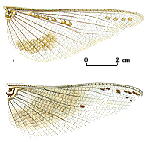Pest locusts
Anacridium spp.
Family : Acrididae
Sub-family : Cyrtacanthacricfinae
Common name : the Tree locust
The Anacridium are outstanding for their dark dense swarms. They are often seen during the day roosting in trees, hence they are commonly called Tree locusts.
There are about a dozen species and a few are economically important pests. These are :
• A. aegyptium (Linné, 1764), the Egyptian Tree locust, distributed from the Mediterranean zone to the Middle East ;
• A. melanorhodon (Walker, 1870) and A. wernerellum (Karny, 1907), found in Africa, the Sahel and Sudan ;
• A. arabafrum Dirsh, 1953, in East Africa and Arabia ;
• A. moestum (Serville, 1838), in South Africa.
There are slight morphological and coloration differences between these species, but generally they look the same. Imagos are large and slender. They are grey or brown, never green, with fine long black antennae. Their eyes are brown with stripes. The elytra are long, with a pinkish tinge at the base of the wings which are quite dark at the ends.
Some Tree locusts belong to the locust category but their gregarious tendencies are not very pronounced. Gregarious are distinguished from the solitarious by a reduced size dimorphism between males and females and by darker colouring. They form very dense swarms of variable size which travel short distances at nightfall. The hoppers are geophilic at first and then become completely arboreal. Isolated hoppers are green or brown and become bright yellow with some dark coloration when grouped.
The biology and ecology of the different Anacridium species vary according to their respective ecoclimatic zones and ranges. Available information on this aspect is patchy.
Anacridium aegyptium is a univoltine species with a winter imaginal diapause. Egg laying occurs during spring, hopper development in summer and the first imagos are observed in autumn. These locusts gather in open groves, croplands and orchards.
Anacridium melanorhodon, the Sahelian Tree locust, is also univoltine with a dry season imaginal diapause. They lay in June-July, hoppers develop in August and September and adults emerge at the onset of the dry season. They colonize Acacia and Balanites thickets in grassy lowlands or mesoxerotrophic croplands.
Anacridium wernerellum, the Sudanese Tree locust, is usually observed in its isolated form, in forested savannahs with Zizyphus, Balanites and Acacias. This species sometimes develops south of its range in Tanzania, two generations per year and one imaginal diapause in the dry season.
Anacridium arabafrum is found in the easternmost part of the range for the genus. Its range borders on that of A. melanorhodon in Sudan. Moreover, ecology, behaviour and life cycle of these two species are very similar.
Anacridium moestum has the southernmost distribution.It is morphologically similar to A. wernerellum but little is known about this acridian. Nonetheless it is thought to have been responsible for severely ravaging fruit trees in South Africa.
Tree Locusts are important occasional pests of fruit trees, citrus, grain crops such as corn, rice, sorghum, manioc and cotton. In tropical regions, gum arabic producing acacias are the most severely affected trees, they are chronically attacked by swarms of migrating imagos in the dry season. Sudan and a few other countries regularly try to control these locusts but such operations are hampered by the frequent night swarm movements and limited access to the wooded biotopes of these acridians. Hoppers can only be effectively treated in the late instar phases, when they are gregarious and aggregated.
General morphology

Size : male is 57-80 mm long, female is 74-95 mm long.
Overall body colour

Wing colour

Prosternal tubercle present
|